Critical Appraisal of Epidemiological Study of COPD among Canadian Aboriginals
VerifiedAdded on 2023/02/01
|9
|2366
|89
AI Summary
This assignment contains a critical appraisal of an article that is based on an epidemiology of COPD, among Canadian Aboriginals. The article selected for the critical appraisal is based on the epidemiological study of visits to the emergency departments, following diagnosis of COPD among Aboriginal individuals, who reside in Alberta, Canada.
Contribute Materials
Your contribution can guide someone’s learning journey. Share your
documents today.
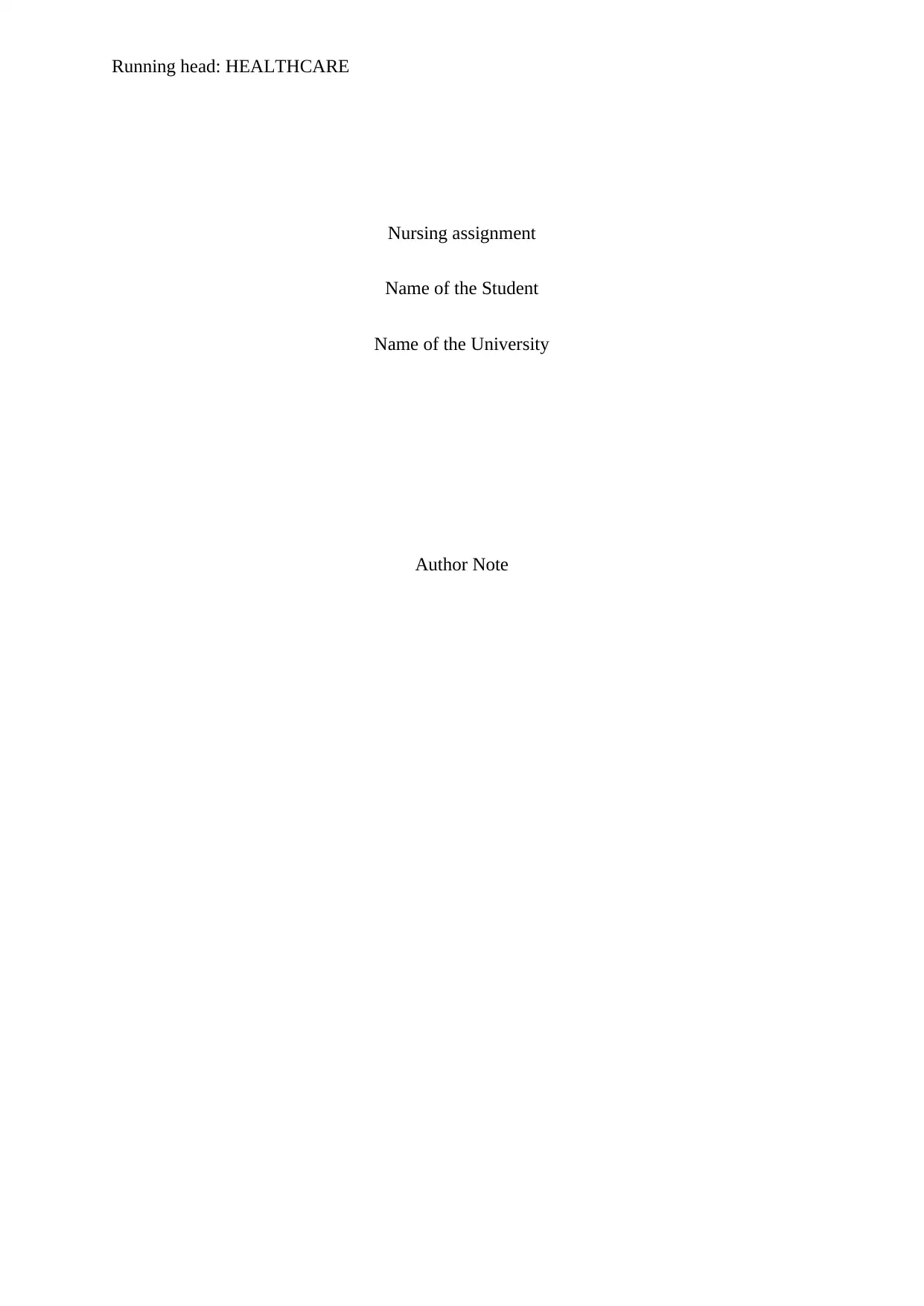
Running head: HEALTHCARE
Nursing assignment
Name of the Student
Name of the University
Author Note
Nursing assignment
Name of the Student
Name of the University
Author Note
Secure Best Marks with AI Grader
Need help grading? Try our AI Grader for instant feedback on your assignments.
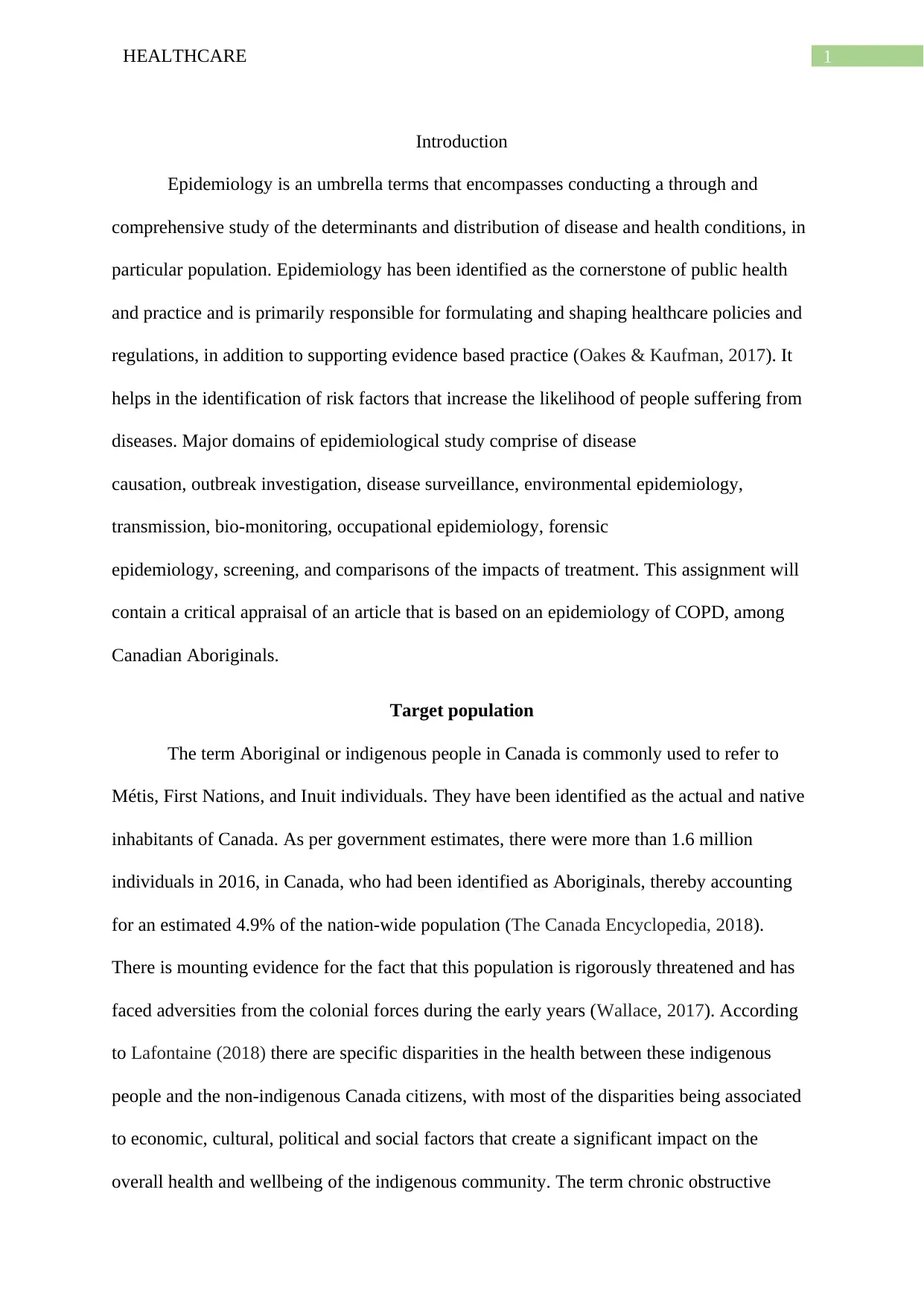
1HEALTHCARE
Introduction
Epidemiology is an umbrella terms that encompasses conducting a through and
comprehensive study of the determinants and distribution of disease and health conditions, in
particular population. Epidemiology has been identified as the cornerstone of public health
and practice and is primarily responsible for formulating and shaping healthcare policies and
regulations, in addition to supporting evidence based practice (Oakes & Kaufman, 2017). It
helps in the identification of risk factors that increase the likelihood of people suffering from
diseases. Major domains of epidemiological study comprise of disease
causation, outbreak investigation, disease surveillance, environmental epidemiology,
transmission, bio-monitoring, occupational epidemiology, forensic
epidemiology, screening, and comparisons of the impacts of treatment. This assignment will
contain a critical appraisal of an article that is based on an epidemiology of COPD, among
Canadian Aboriginals.
Target population
The term Aboriginal or indigenous people in Canada is commonly used to refer to
Métis, First Nations, and Inuit individuals. They have been identified as the actual and native
inhabitants of Canada. As per government estimates, there were more than 1.6 million
individuals in 2016, in Canada, who had been identified as Aboriginals, thereby accounting
for an estimated 4.9% of the nation-wide population (The Canada Encyclopedia, 2018).
There is mounting evidence for the fact that this population is rigorously threatened and has
faced adversities from the colonial forces during the early years (Wallace, 2017). According
to Lafontaine (2018) there are specific disparities in the health between these indigenous
people and the non-indigenous Canada citizens, with most of the disparities being associated
to economic, cultural, political and social factors that create a significant impact on the
overall health and wellbeing of the indigenous community. The term chronic obstructive
Introduction
Epidemiology is an umbrella terms that encompasses conducting a through and
comprehensive study of the determinants and distribution of disease and health conditions, in
particular population. Epidemiology has been identified as the cornerstone of public health
and practice and is primarily responsible for formulating and shaping healthcare policies and
regulations, in addition to supporting evidence based practice (Oakes & Kaufman, 2017). It
helps in the identification of risk factors that increase the likelihood of people suffering from
diseases. Major domains of epidemiological study comprise of disease
causation, outbreak investigation, disease surveillance, environmental epidemiology,
transmission, bio-monitoring, occupational epidemiology, forensic
epidemiology, screening, and comparisons of the impacts of treatment. This assignment will
contain a critical appraisal of an article that is based on an epidemiology of COPD, among
Canadian Aboriginals.
Target population
The term Aboriginal or indigenous people in Canada is commonly used to refer to
Métis, First Nations, and Inuit individuals. They have been identified as the actual and native
inhabitants of Canada. As per government estimates, there were more than 1.6 million
individuals in 2016, in Canada, who had been identified as Aboriginals, thereby accounting
for an estimated 4.9% of the nation-wide population (The Canada Encyclopedia, 2018).
There is mounting evidence for the fact that this population is rigorously threatened and has
faced adversities from the colonial forces during the early years (Wallace, 2017). According
to Lafontaine (2018) there are specific disparities in the health between these indigenous
people and the non-indigenous Canada citizens, with most of the disparities being associated
to economic, cultural, political and social factors that create a significant impact on the
overall health and wellbeing of the indigenous community. The term chronic obstructive
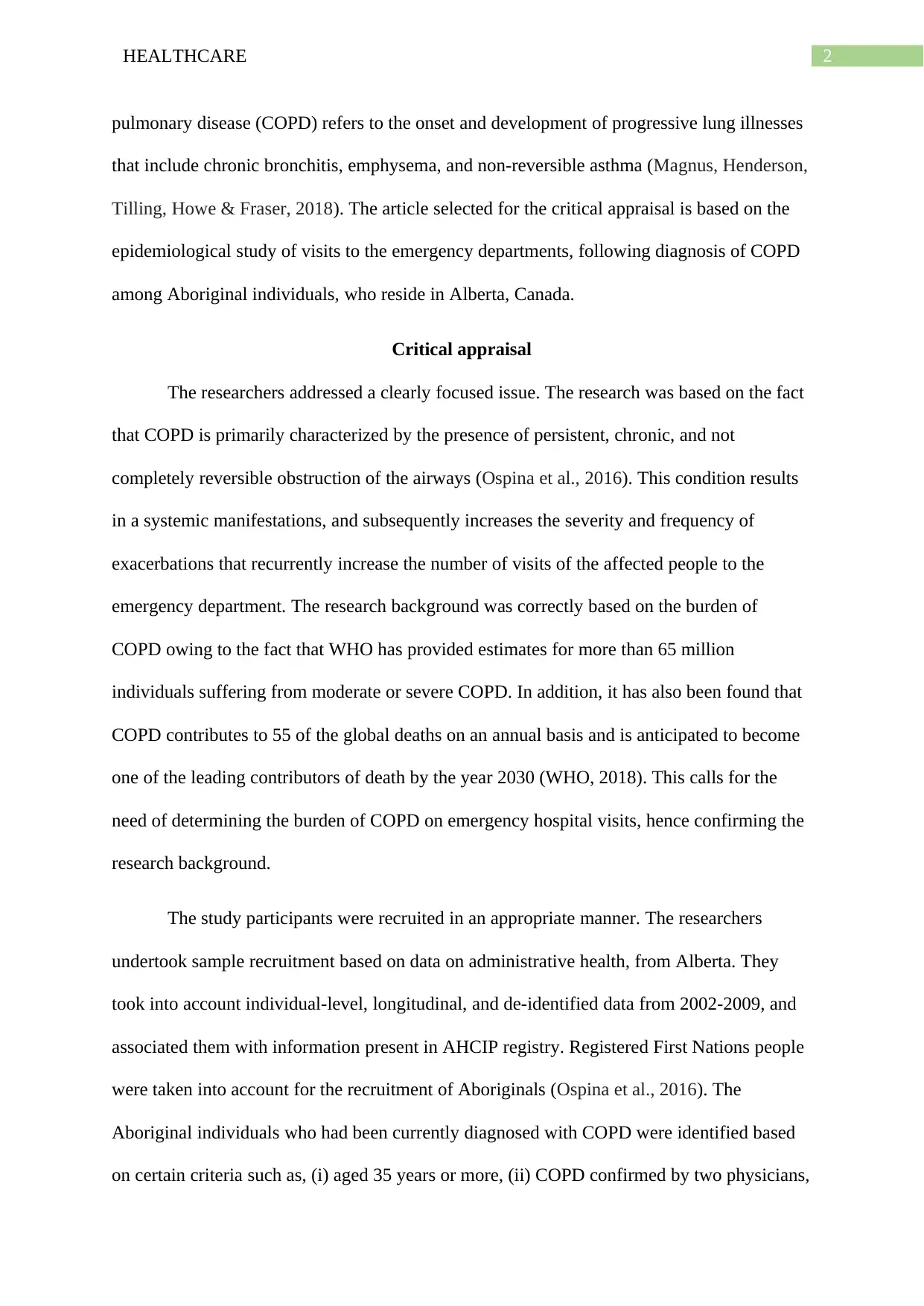
2HEALTHCARE
pulmonary disease (COPD) refers to the onset and development of progressive lung illnesses
that include chronic bronchitis, emphysema, and non-reversible asthma (Magnus, Henderson,
Tilling, Howe & Fraser, 2018). The article selected for the critical appraisal is based on the
epidemiological study of visits to the emergency departments, following diagnosis of COPD
among Aboriginal individuals, who reside in Alberta, Canada.
Critical appraisal
The researchers addressed a clearly focused issue. The research was based on the fact
that COPD is primarily characterized by the presence of persistent, chronic, and not
completely reversible obstruction of the airways (Ospina et al., 2016). This condition results
in a systemic manifestations, and subsequently increases the severity and frequency of
exacerbations that recurrently increase the number of visits of the affected people to the
emergency department. The research background was correctly based on the burden of
COPD owing to the fact that WHO has provided estimates for more than 65 million
individuals suffering from moderate or severe COPD. In addition, it has also been found that
COPD contributes to 55 of the global deaths on an annual basis and is anticipated to become
one of the leading contributors of death by the year 2030 (WHO, 2018). This calls for the
need of determining the burden of COPD on emergency hospital visits, hence confirming the
research background.
The study participants were recruited in an appropriate manner. The researchers
undertook sample recruitment based on data on administrative health, from Alberta. They
took into account individual-level, longitudinal, and de-identified data from 2002-2009, and
associated them with information present in AHCIP registry. Registered First Nations people
were taken into account for the recruitment of Aboriginals (Ospina et al., 2016). The
Aboriginal individuals who had been currently diagnosed with COPD were identified based
on certain criteria such as, (i) aged 35 years or more, (ii) COPD confirmed by two physicians,
pulmonary disease (COPD) refers to the onset and development of progressive lung illnesses
that include chronic bronchitis, emphysema, and non-reversible asthma (Magnus, Henderson,
Tilling, Howe & Fraser, 2018). The article selected for the critical appraisal is based on the
epidemiological study of visits to the emergency departments, following diagnosis of COPD
among Aboriginal individuals, who reside in Alberta, Canada.
Critical appraisal
The researchers addressed a clearly focused issue. The research was based on the fact
that COPD is primarily characterized by the presence of persistent, chronic, and not
completely reversible obstruction of the airways (Ospina et al., 2016). This condition results
in a systemic manifestations, and subsequently increases the severity and frequency of
exacerbations that recurrently increase the number of visits of the affected people to the
emergency department. The research background was correctly based on the burden of
COPD owing to the fact that WHO has provided estimates for more than 65 million
individuals suffering from moderate or severe COPD. In addition, it has also been found that
COPD contributes to 55 of the global deaths on an annual basis and is anticipated to become
one of the leading contributors of death by the year 2030 (WHO, 2018). This calls for the
need of determining the burden of COPD on emergency hospital visits, hence confirming the
research background.
The study participants were recruited in an appropriate manner. The researchers
undertook sample recruitment based on data on administrative health, from Alberta. They
took into account individual-level, longitudinal, and de-identified data from 2002-2009, and
associated them with information present in AHCIP registry. Registered First Nations people
were taken into account for the recruitment of Aboriginals (Ospina et al., 2016). The
Aboriginal individuals who had been currently diagnosed with COPD were identified based
on certain criteria such as, (i) aged 35 years or more, (ii) COPD confirmed by two physicians,
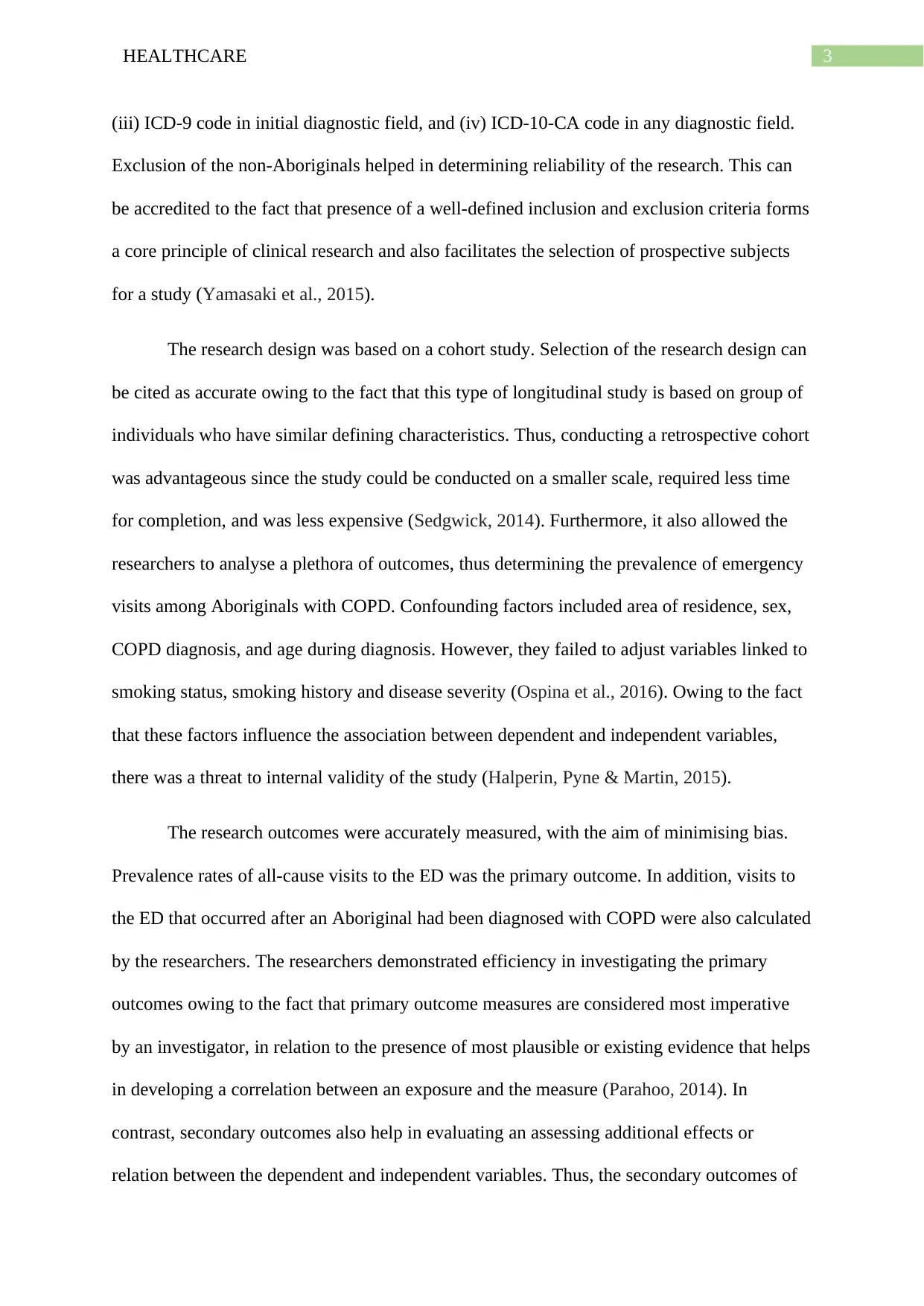
3HEALTHCARE
(iii) ICD-9 code in initial diagnostic field, and (iv) ICD-10-CA code in any diagnostic field.
Exclusion of the non-Aboriginals helped in determining reliability of the research. This can
be accredited to the fact that presence of a well-defined inclusion and exclusion criteria forms
a core principle of clinical research and also facilitates the selection of prospective subjects
for a study (Yamasaki et al., 2015).
The research design was based on a cohort study. Selection of the research design can
be cited as accurate owing to the fact that this type of longitudinal study is based on group of
individuals who have similar defining characteristics. Thus, conducting a retrospective cohort
was advantageous since the study could be conducted on a smaller scale, required less time
for completion, and was less expensive (Sedgwick, 2014). Furthermore, it also allowed the
researchers to analyse a plethora of outcomes, thus determining the prevalence of emergency
visits among Aboriginals with COPD. Confounding factors included area of residence, sex,
COPD diagnosis, and age during diagnosis. However, they failed to adjust variables linked to
smoking status, smoking history and disease severity (Ospina et al., 2016). Owing to the fact
that these factors influence the association between dependent and independent variables,
there was a threat to internal validity of the study (Halperin, Pyne & Martin, 2015).
The research outcomes were accurately measured, with the aim of minimising bias.
Prevalence rates of all-cause visits to the ED was the primary outcome. In addition, visits to
the ED that occurred after an Aboriginal had been diagnosed with COPD were also calculated
by the researchers. The researchers demonstrated efficiency in investigating the primary
outcomes owing to the fact that primary outcome measures are considered most imperative
by an investigator, in relation to the presence of most plausible or existing evidence that helps
in developing a correlation between an exposure and the measure (Parahoo, 2014). In
contrast, secondary outcomes also help in evaluating an assessing additional effects or
relation between the dependent and independent variables. Thus, the secondary outcomes of
(iii) ICD-9 code in initial diagnostic field, and (iv) ICD-10-CA code in any diagnostic field.
Exclusion of the non-Aboriginals helped in determining reliability of the research. This can
be accredited to the fact that presence of a well-defined inclusion and exclusion criteria forms
a core principle of clinical research and also facilitates the selection of prospective subjects
for a study (Yamasaki et al., 2015).
The research design was based on a cohort study. Selection of the research design can
be cited as accurate owing to the fact that this type of longitudinal study is based on group of
individuals who have similar defining characteristics. Thus, conducting a retrospective cohort
was advantageous since the study could be conducted on a smaller scale, required less time
for completion, and was less expensive (Sedgwick, 2014). Furthermore, it also allowed the
researchers to analyse a plethora of outcomes, thus determining the prevalence of emergency
visits among Aboriginals with COPD. Confounding factors included area of residence, sex,
COPD diagnosis, and age during diagnosis. However, they failed to adjust variables linked to
smoking status, smoking history and disease severity (Ospina et al., 2016). Owing to the fact
that these factors influence the association between dependent and independent variables,
there was a threat to internal validity of the study (Halperin, Pyne & Martin, 2015).
The research outcomes were accurately measured, with the aim of minimising bias.
Prevalence rates of all-cause visits to the ED was the primary outcome. In addition, visits to
the ED that occurred after an Aboriginal had been diagnosed with COPD were also calculated
by the researchers. The researchers demonstrated efficiency in investigating the primary
outcomes owing to the fact that primary outcome measures are considered most imperative
by an investigator, in relation to the presence of most plausible or existing evidence that helps
in developing a correlation between an exposure and the measure (Parahoo, 2014). In
contrast, secondary outcomes also help in evaluating an assessing additional effects or
relation between the dependent and independent variables. Thus, the secondary outcomes of
Secure Best Marks with AI Grader
Need help grading? Try our AI Grader for instant feedback on your assignments.
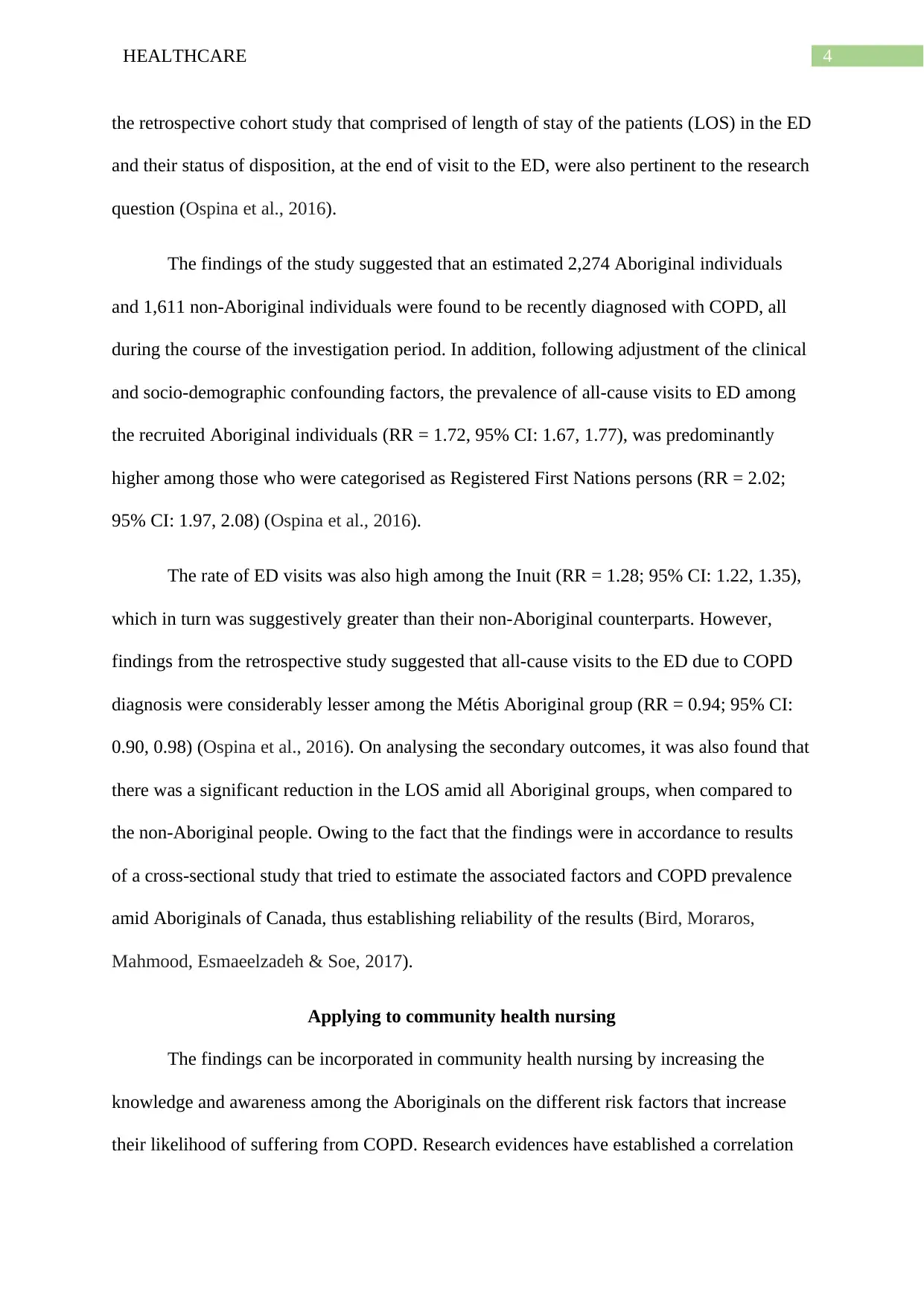
4HEALTHCARE
the retrospective cohort study that comprised of length of stay of the patients (LOS) in the ED
and their status of disposition, at the end of visit to the ED, were also pertinent to the research
question (Ospina et al., 2016).
The findings of the study suggested that an estimated 2,274 Aboriginal individuals
and 1,611 non-Aboriginal individuals were found to be recently diagnosed with COPD, all
during the course of the investigation period. In addition, following adjustment of the clinical
and socio-demographic confounding factors, the prevalence of all-cause visits to ED among
the recruited Aboriginal individuals (RR = 1.72, 95% CI: 1.67, 1.77), was predominantly
higher among those who were categorised as Registered First Nations persons (RR = 2.02;
95% CI: 1.97, 2.08) (Ospina et al., 2016).
The rate of ED visits was also high among the Inuit (RR = 1.28; 95% CI: 1.22, 1.35),
which in turn was suggestively greater than their non-Aboriginal counterparts. However,
findings from the retrospective study suggested that all-cause visits to the ED due to COPD
diagnosis were considerably lesser among the Métis Aboriginal group (RR = 0.94; 95% CI:
0.90, 0.98) (Ospina et al., 2016). On analysing the secondary outcomes, it was also found that
there was a significant reduction in the LOS amid all Aboriginal groups, when compared to
the non-Aboriginal people. Owing to the fact that the findings were in accordance to results
of a cross-sectional study that tried to estimate the associated factors and COPD prevalence
amid Aboriginals of Canada, thus establishing reliability of the results (Bird, Moraros,
Mahmood, Esmaeelzadeh & Soe, 2017).
Applying to community health nursing
The findings can be incorporated in community health nursing by increasing the
knowledge and awareness among the Aboriginals on the different risk factors that increase
their likelihood of suffering from COPD. Research evidences have established a correlation
the retrospective cohort study that comprised of length of stay of the patients (LOS) in the ED
and their status of disposition, at the end of visit to the ED, were also pertinent to the research
question (Ospina et al., 2016).
The findings of the study suggested that an estimated 2,274 Aboriginal individuals
and 1,611 non-Aboriginal individuals were found to be recently diagnosed with COPD, all
during the course of the investigation period. In addition, following adjustment of the clinical
and socio-demographic confounding factors, the prevalence of all-cause visits to ED among
the recruited Aboriginal individuals (RR = 1.72, 95% CI: 1.67, 1.77), was predominantly
higher among those who were categorised as Registered First Nations persons (RR = 2.02;
95% CI: 1.97, 2.08) (Ospina et al., 2016).
The rate of ED visits was also high among the Inuit (RR = 1.28; 95% CI: 1.22, 1.35),
which in turn was suggestively greater than their non-Aboriginal counterparts. However,
findings from the retrospective study suggested that all-cause visits to the ED due to COPD
diagnosis were considerably lesser among the Métis Aboriginal group (RR = 0.94; 95% CI:
0.90, 0.98) (Ospina et al., 2016). On analysing the secondary outcomes, it was also found that
there was a significant reduction in the LOS amid all Aboriginal groups, when compared to
the non-Aboriginal people. Owing to the fact that the findings were in accordance to results
of a cross-sectional study that tried to estimate the associated factors and COPD prevalence
amid Aboriginals of Canada, thus establishing reliability of the results (Bird, Moraros,
Mahmood, Esmaeelzadeh & Soe, 2017).
Applying to community health nursing
The findings can be incorporated in community health nursing by increasing the
knowledge and awareness among the Aboriginals on the different risk factors that increase
their likelihood of suffering from COPD. Research evidences have established a correlation
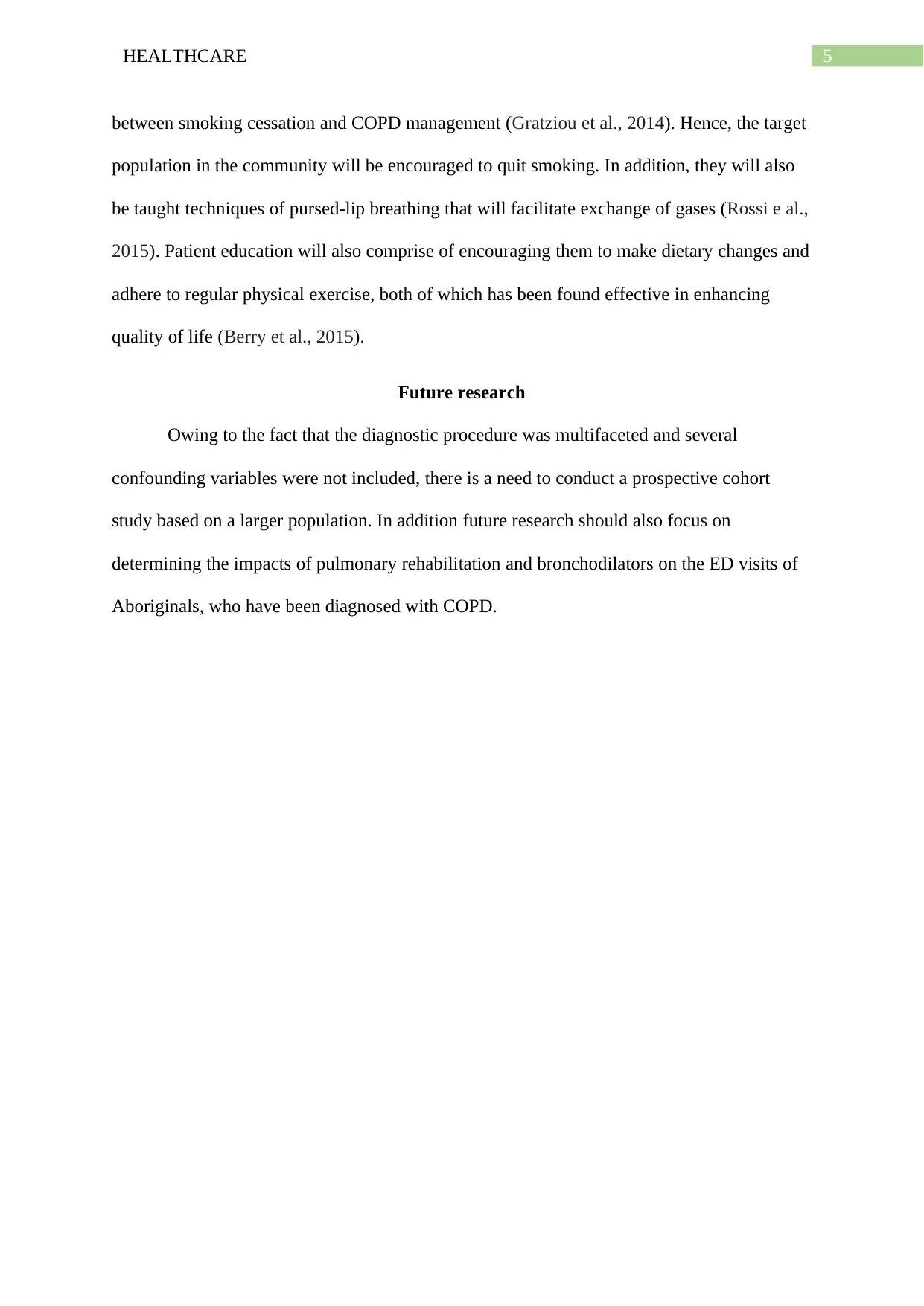
5HEALTHCARE
between smoking cessation and COPD management (Gratziou et al., 2014). Hence, the target
population in the community will be encouraged to quit smoking. In addition, they will also
be taught techniques of pursed-lip breathing that will facilitate exchange of gases (Rossi e al.,
2015). Patient education will also comprise of encouraging them to make dietary changes and
adhere to regular physical exercise, both of which has been found effective in enhancing
quality of life (Berry et al., 2015).
Future research
Owing to the fact that the diagnostic procedure was multifaceted and several
confounding variables were not included, there is a need to conduct a prospective cohort
study based on a larger population. In addition future research should also focus on
determining the impacts of pulmonary rehabilitation and bronchodilators on the ED visits of
Aboriginals, who have been diagnosed with COPD.
between smoking cessation and COPD management (Gratziou et al., 2014). Hence, the target
population in the community will be encouraged to quit smoking. In addition, they will also
be taught techniques of pursed-lip breathing that will facilitate exchange of gases (Rossi e al.,
2015). Patient education will also comprise of encouraging them to make dietary changes and
adhere to regular physical exercise, both of which has been found effective in enhancing
quality of life (Berry et al., 2015).
Future research
Owing to the fact that the diagnostic procedure was multifaceted and several
confounding variables were not included, there is a need to conduct a prospective cohort
study based on a larger population. In addition future research should also focus on
determining the impacts of pulmonary rehabilitation and bronchodilators on the ED visits of
Aboriginals, who have been diagnosed with COPD.
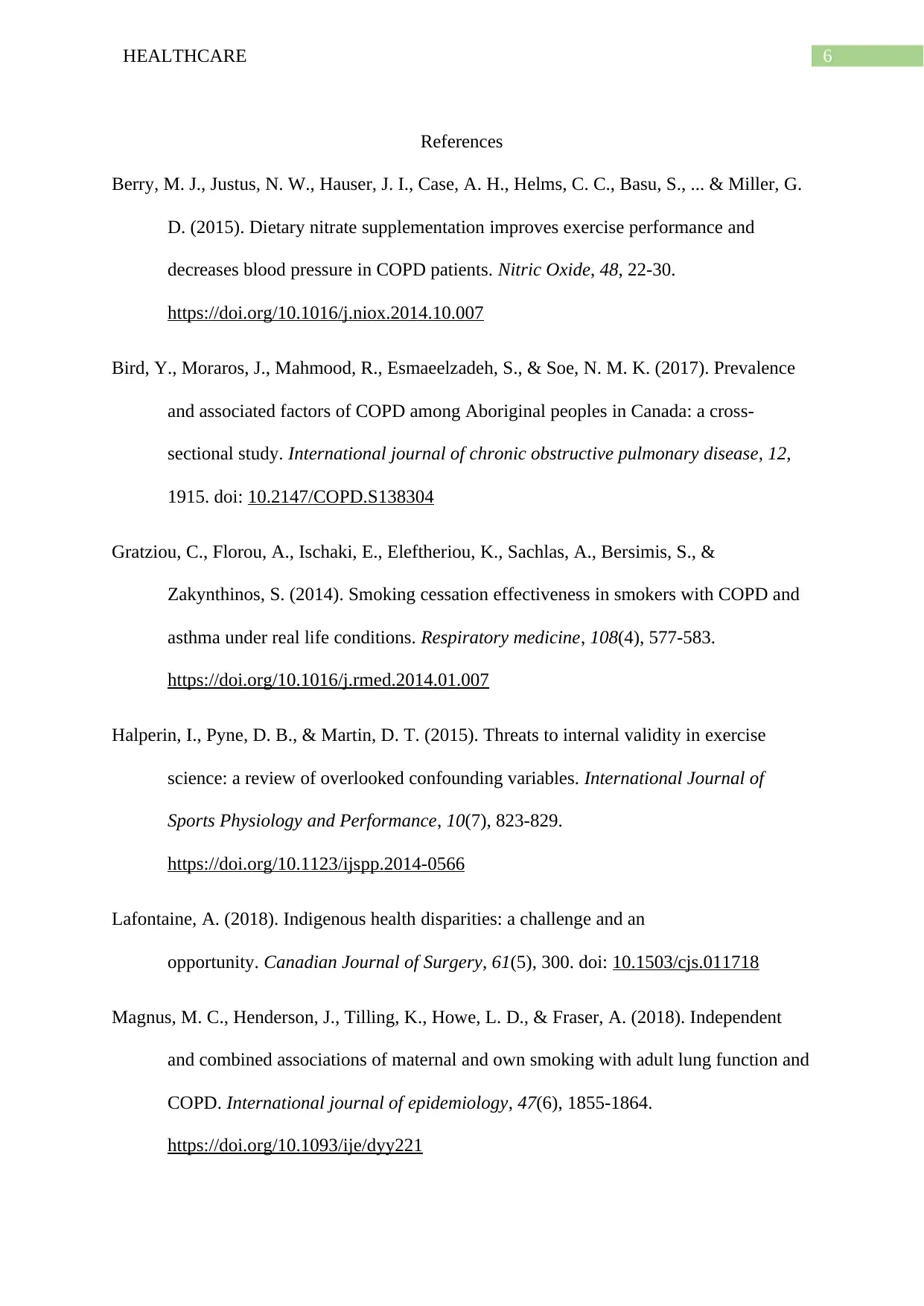
6HEALTHCARE
References
Berry, M. J., Justus, N. W., Hauser, J. I., Case, A. H., Helms, C. C., Basu, S., ... & Miller, G.
D. (2015). Dietary nitrate supplementation improves exercise performance and
decreases blood pressure in COPD patients. Nitric Oxide, 48, 22-30.
https://doi.org/10.1016/j.niox.2014.10.007
Bird, Y., Moraros, J., Mahmood, R., Esmaeelzadeh, S., & Soe, N. M. K. (2017). Prevalence
and associated factors of COPD among Aboriginal peoples in Canada: a cross-
sectional study. International journal of chronic obstructive pulmonary disease, 12,
1915. doi: 10.2147/COPD.S138304
Gratziou, C., Florou, A., Ischaki, E., Eleftheriou, K., Sachlas, A., Bersimis, S., &
Zakynthinos, S. (2014). Smoking cessation effectiveness in smokers with COPD and
asthma under real life conditions. Respiratory medicine, 108(4), 577-583.
https://doi.org/10.1016/j.rmed.2014.01.007
Halperin, I., Pyne, D. B., & Martin, D. T. (2015). Threats to internal validity in exercise
science: a review of overlooked confounding variables. International Journal of
Sports Physiology and Performance, 10(7), 823-829.
https://doi.org/10.1123/ijspp.2014-0566
Lafontaine, A. (2018). Indigenous health disparities: a challenge and an
opportunity. Canadian Journal of Surgery, 61(5), 300. doi: 10.1503/cjs.011718
Magnus, M. C., Henderson, J., Tilling, K., Howe, L. D., & Fraser, A. (2018). Independent
and combined associations of maternal and own smoking with adult lung function and
COPD. International journal of epidemiology, 47(6), 1855-1864.
https://doi.org/10.1093/ije/dyy221
References
Berry, M. J., Justus, N. W., Hauser, J. I., Case, A. H., Helms, C. C., Basu, S., ... & Miller, G.
D. (2015). Dietary nitrate supplementation improves exercise performance and
decreases blood pressure in COPD patients. Nitric Oxide, 48, 22-30.
https://doi.org/10.1016/j.niox.2014.10.007
Bird, Y., Moraros, J., Mahmood, R., Esmaeelzadeh, S., & Soe, N. M. K. (2017). Prevalence
and associated factors of COPD among Aboriginal peoples in Canada: a cross-
sectional study. International journal of chronic obstructive pulmonary disease, 12,
1915. doi: 10.2147/COPD.S138304
Gratziou, C., Florou, A., Ischaki, E., Eleftheriou, K., Sachlas, A., Bersimis, S., &
Zakynthinos, S. (2014). Smoking cessation effectiveness in smokers with COPD and
asthma under real life conditions. Respiratory medicine, 108(4), 577-583.
https://doi.org/10.1016/j.rmed.2014.01.007
Halperin, I., Pyne, D. B., & Martin, D. T. (2015). Threats to internal validity in exercise
science: a review of overlooked confounding variables. International Journal of
Sports Physiology and Performance, 10(7), 823-829.
https://doi.org/10.1123/ijspp.2014-0566
Lafontaine, A. (2018). Indigenous health disparities: a challenge and an
opportunity. Canadian Journal of Surgery, 61(5), 300. doi: 10.1503/cjs.011718
Magnus, M. C., Henderson, J., Tilling, K., Howe, L. D., & Fraser, A. (2018). Independent
and combined associations of maternal and own smoking with adult lung function and
COPD. International journal of epidemiology, 47(6), 1855-1864.
https://doi.org/10.1093/ije/dyy221
Paraphrase This Document
Need a fresh take? Get an instant paraphrase of this document with our AI Paraphraser

7HEALTHCARE
Oakes, J. M., & Kaufman, J. S. (Eds.). (2017). Methods in social epidemiology (Vol. 16).
John Wiley & Sons. Retrieved from https://books.google.co.in/books?
hl=en&lr=&id=_WIWDgAAQBAJ&oi=fnd&pg=PR16&dq=epidemiology&ots=sZA
6nTmw_Q&sig=OgWsxgtqsywKunqpAYQT1Vs8NCE#v=onepage&q=epidemiolog
y&f=false
Ospina, M. B., Rowe, B. H., Voaklander, D., Senthilselvan, A., Stickland, M. K., & King, M.
(2016). Emergency department visits after diagnosed chronic obstructive pulmonary
disease in aboriginal people in Alberta, Canada. Canadian Journal of Emergency
Medicine, 18(6), 420-428. https://doi.org/10.1017/cem.2016.328
Parahoo, K. (2014). Nursing research: principles, process and issues. Macmillan
International Higher Education. Retrieved from https://books.google.co.in/books?
hl=en&lr=&id=5ti3AwAAQBAJ&oi=fnd&pg=PP1&dq=parahoo+2014&ots=RByFY
BJpA_&sig=Cp1qzwbFAOmR0anrDfGxu-DgX98#v=onepage&q=parahoo
%202014&f=false
Rossi, R. C., Vanderlei, F. M., Bernardo, A. F., Souza, N. M. D., Goncalves, A. C. C. R.,
Ramos, E. M. C., ... & Vanderlei, L. C. M. (2014). Effect of pursed-lip breathing in
patients with COPD: linear and nonlinear analysis of cardiac autonomic
modulation. COPD: Journal of Chronic Obstructive Pulmonary Disease, 11(1), 39-
45. https://doi.org/10.3109/15412555.2013.825593
Sedgwick, P. (2014). Cross sectional studies: advantages and disadvantages. Bmj, 348,
g2276. https://doi.org/10.1136/bmj.g2276
The Canada Encyclopedia. (2018). Indigenous Peoples in Canada. Retrieved from
https://www.thecanadianencyclopedia.ca/en/article/aboriginal-people
Oakes, J. M., & Kaufman, J. S. (Eds.). (2017). Methods in social epidemiology (Vol. 16).
John Wiley & Sons. Retrieved from https://books.google.co.in/books?
hl=en&lr=&id=_WIWDgAAQBAJ&oi=fnd&pg=PR16&dq=epidemiology&ots=sZA
6nTmw_Q&sig=OgWsxgtqsywKunqpAYQT1Vs8NCE#v=onepage&q=epidemiolog
y&f=false
Ospina, M. B., Rowe, B. H., Voaklander, D., Senthilselvan, A., Stickland, M. K., & King, M.
(2016). Emergency department visits after diagnosed chronic obstructive pulmonary
disease in aboriginal people in Alberta, Canada. Canadian Journal of Emergency
Medicine, 18(6), 420-428. https://doi.org/10.1017/cem.2016.328
Parahoo, K. (2014). Nursing research: principles, process and issues. Macmillan
International Higher Education. Retrieved from https://books.google.co.in/books?
hl=en&lr=&id=5ti3AwAAQBAJ&oi=fnd&pg=PP1&dq=parahoo+2014&ots=RByFY
BJpA_&sig=Cp1qzwbFAOmR0anrDfGxu-DgX98#v=onepage&q=parahoo
%202014&f=false
Rossi, R. C., Vanderlei, F. M., Bernardo, A. F., Souza, N. M. D., Goncalves, A. C. C. R.,
Ramos, E. M. C., ... & Vanderlei, L. C. M. (2014). Effect of pursed-lip breathing in
patients with COPD: linear and nonlinear analysis of cardiac autonomic
modulation. COPD: Journal of Chronic Obstructive Pulmonary Disease, 11(1), 39-
45. https://doi.org/10.3109/15412555.2013.825593
Sedgwick, P. (2014). Cross sectional studies: advantages and disadvantages. Bmj, 348,
g2276. https://doi.org/10.1136/bmj.g2276
The Canada Encyclopedia. (2018). Indigenous Peoples in Canada. Retrieved from
https://www.thecanadianencyclopedia.ca/en/article/aboriginal-people
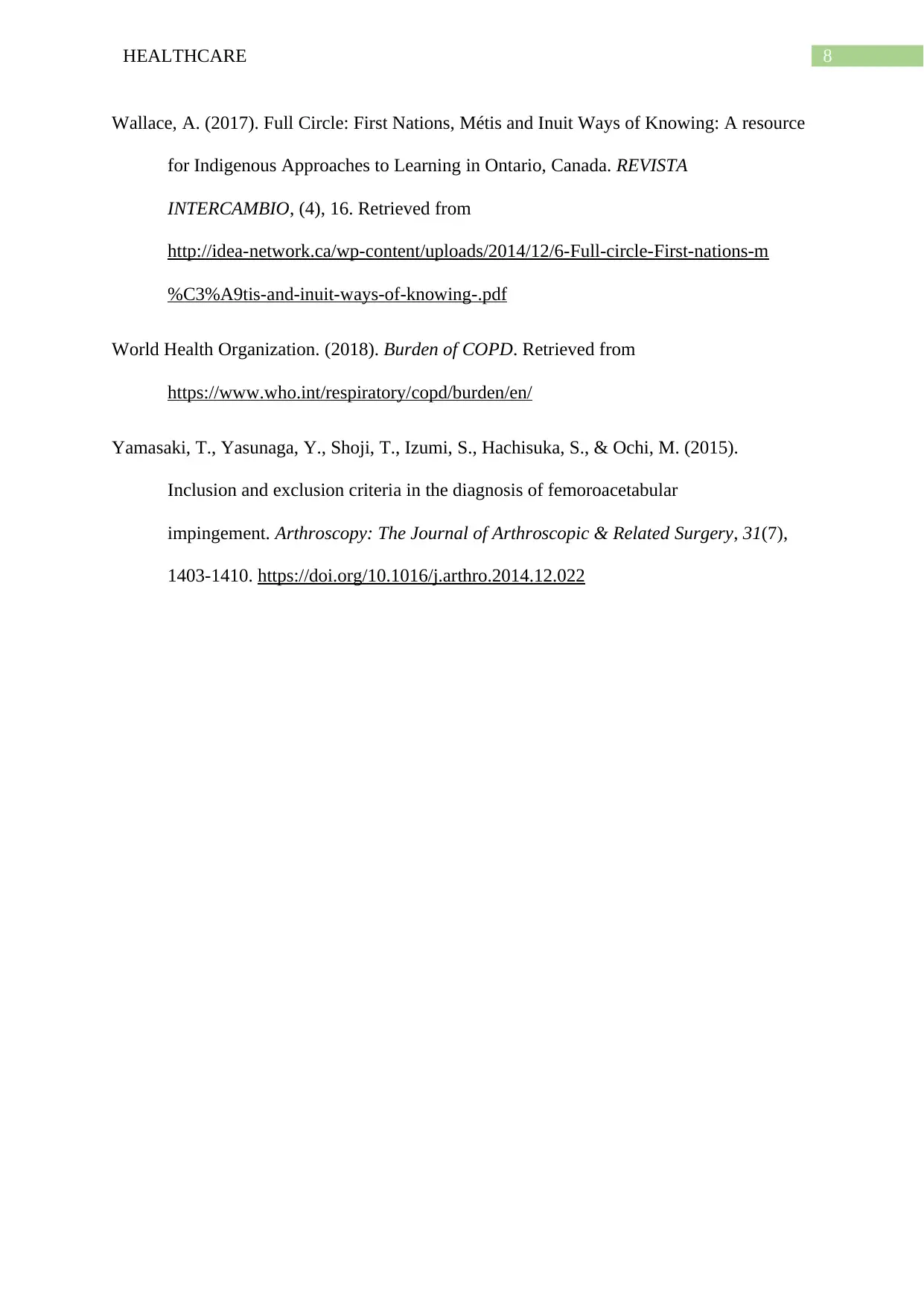
8HEALTHCARE
Wallace, A. (2017). Full Circle: First Nations, Métis and Inuit Ways of Knowing: A resource
for Indigenous Approaches to Learning in Ontario, Canada. REVISTA
INTERCAMBIO, (4), 16. Retrieved from
http://idea-network.ca/wp-content/uploads/2014/12/6-Full-circle-First-nations-m
%C3%A9tis-and-inuit-ways-of-knowing-.pdf
World Health Organization. (2018). Burden of COPD. Retrieved from
https://www.who.int/respiratory/copd/burden/en/
Yamasaki, T., Yasunaga, Y., Shoji, T., Izumi, S., Hachisuka, S., & Ochi, M. (2015).
Inclusion and exclusion criteria in the diagnosis of femoroacetabular
impingement. Arthroscopy: The Journal of Arthroscopic & Related Surgery, 31(7),
1403-1410. https://doi.org/10.1016/j.arthro.2014.12.022
Wallace, A. (2017). Full Circle: First Nations, Métis and Inuit Ways of Knowing: A resource
for Indigenous Approaches to Learning in Ontario, Canada. REVISTA
INTERCAMBIO, (4), 16. Retrieved from
http://idea-network.ca/wp-content/uploads/2014/12/6-Full-circle-First-nations-m
%C3%A9tis-and-inuit-ways-of-knowing-.pdf
World Health Organization. (2018). Burden of COPD. Retrieved from
https://www.who.int/respiratory/copd/burden/en/
Yamasaki, T., Yasunaga, Y., Shoji, T., Izumi, S., Hachisuka, S., & Ochi, M. (2015).
Inclusion and exclusion criteria in the diagnosis of femoroacetabular
impingement. Arthroscopy: The Journal of Arthroscopic & Related Surgery, 31(7),
1403-1410. https://doi.org/10.1016/j.arthro.2014.12.022
1 out of 9
Related Documents
Your All-in-One AI-Powered Toolkit for Academic Success.
+13062052269
info@desklib.com
Available 24*7 on WhatsApp / Email
![[object Object]](/_next/static/media/star-bottom.7253800d.svg)
Unlock your academic potential
© 2024 | Zucol Services PVT LTD | All rights reserved.





